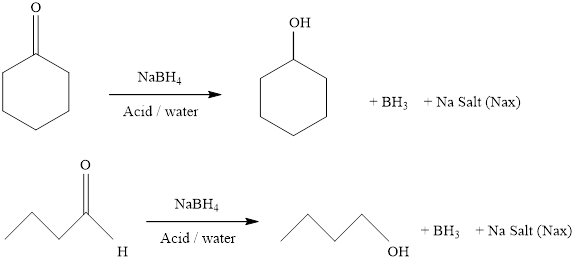
(a)
Interpretation:
It should be determined that the alcohol which is obtained from the reduction of 2-methylpropanal with sodium borohydrate.
Concept introduction:

(b)
Interpretation:
It should be determined that the alcohol which is obtained from the reduction of cyclohexanone with sodium borohydrate.
Concept introduction:
Aldehydes and ketons react with sodium borohydrate undergoes reduction to forms alcohols.

(c)
Interpretation:
It should be determined that the alcohol which is obtained from the reduction of tert-butylcyclohexanone with sodium borohydrate.
Concept introduction:
Aldehydes and ketons react with sodium borohydrate undergoes reduction to forms alcohols.

(d)
Interpretation:
It should be determined that the alcohol which is obtained from the reduction of acetophenone with sodium borohydrate.
Concept introduction:
Aldehydes and ketons react with sodium borohydrate undergoes reduction to forms alcohols.

Want to see the full answer?
Check out a sample textbook solution
Chapter 17 Solutions
Organic Chemistry
- Convert benzene into attached compound. You may also use any inorganicreagents and organic alcohols having four or fewer carbons. One step of the synthesis must use a Grignard reagent.arrow_forwardWhat happens when an aldehyde gives a silver mirror when treated with Tollen’s reagent and give red-brown precipitate when treated with Fehling’s solution? Explain how they are formed using chemical equations.arrow_forwardSynthetize 3-pentynal from 3-butynal using whatever organic/inorganic reagents are needed.arrow_forward
- Convert benzene into each compound. You may also use any inorganic reagents and organic alcohols having four or fewer carbons. One step of the synthesis must use a Grignard reagent.arrow_forwardWhen performing a Grignard reaction it is also very important that the reaction be free from acetone (a chemical we commonly use to clean the glassware). Why must the glassware be free from acetone? A. Acetone reacts with the diethyl ether causing a side reaction to occur B. Acetone is a nucleophile that will react with the Grignard reagent C. Acetone reacts with the bromobenzene D. Acetone is an electrophile that will react with the Grignard reagentarrow_forwardWhy is it not advisable to use aqueous hydrochloric acid in a Grignard reaction of a ketone? A) The Grignard reagent will react with the acid and cannot react with the ketone. B) The ketone will be protonated and will become unreactive. C) The ketone will form an unreactive enol. D) The Grignard reagent won't dissolve in aqueous solutionsarrow_forward
- Consider the reaction of an alkyl bromide with water. Draw the neutral organic products.arrow_forwardConvert benzene into each compound. You may also use any inorganic reagents and organic alcohols having three carbons or fewer. One step of the synthesis must use a Grignard reagent.arrow_forwardWittig reactions with the following -chloroethers can be used for the synthesis of aldehydes and ketones. (a) Draw the structure of the triphenylphosphonium salt and Wittig reagent formed from each chloroether. (b) Draw the structural formula of the product formed by treating each Wittig reagent with cyclopentanone. Note that the functional group is an enol ether or, alternatively, a vinyl ether. (c) Draw the structural formula of the product formed on acid-catalyzed hydrolysis of each enol ether from part (b).arrow_forward
- What would be the organic product for each reaction?arrow_forwardWhat reagents could be used to reduce the nitro group ?arrow_forward7. GIVE AN EXAMPLE OF AN ENOL IN BIOLOGICAL SYSTEM 8. WHAT IS FEHLING'S TEST? WHAT ARE THE CONSTITUENTS OF FEHLING'S REAGENT? 10. HOW DOES FEHLING'S TEST COMPARE TO BENEDICT'S AND TOLLEN'S TEST?arrow_forward
 Organic ChemistryChemistryISBN:9781305580350Author:William H. Brown, Brent L. Iverson, Eric Anslyn, Christopher S. FootePublisher:Cengage Learning
Organic ChemistryChemistryISBN:9781305580350Author:William H. Brown, Brent L. Iverson, Eric Anslyn, Christopher S. FootePublisher:Cengage Learning Organic Chemistry: A Guided InquiryChemistryISBN:9780618974122Author:Andrei StraumanisPublisher:Cengage Learning
Organic Chemistry: A Guided InquiryChemistryISBN:9780618974122Author:Andrei StraumanisPublisher:Cengage Learning

